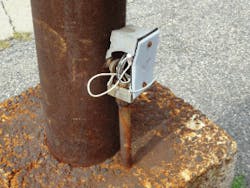Rust is a Secondary Concern at This Location
I feel like a broken record that is stuck playing the same message: “This is a common problem… This is a common problem…” I have many other images showing this same type of situation.
I found this particular damaged box at the base of a sign on the corner of a commercial property parking lot. This type of electrical equipment can easily be damaged by car or truck bumpers. In areas where it snows, this damage is often caused by a shovel or snow plow.
Again, protection from physical damage comes to mind. See the following NEC index references for rules that cover the physical protection of equipment:
- Conductors [250.64(B), 300.4, and 300.50(B)]
- Cabinets, cutout boxes, and meter socket enclosures [312.5]
- Armored cable [320.12 and 320.15]
- Busways [368.12(A)]
- Wiring methods in agricultural buildings [547.5(E)]
- Audio signal processing, amplification, and reproduction equipment [640.45]
- CATV coaxial cable [820.100(A)(6)]
- Communications systems [800.100(A)(6)].
Nothing Beats a Little Air Space
Although this rigid metal conduit (RMC) was installed long ago, we can see where the concentric knockout was removed to accept the 1½-in. threaded entry. The opening that was left here can, and often will, lead to corrosion and loss of equipment bonding and grounding. Section 250.92(B) covers the proper method of bonding at the service. “Bonding jumpers meeting the requirements of this article shall be used around impaired connections, such as reducing washers or oversized, concentric, or eccentric knockouts. Standard locknuts or bushings shall not be the only means for the bonding required by this section but shall be permitted to be installed to make a mechanical connection of the raceway(s).” If we were able to look inside this particular cabinet, we would look for a bonding bushing too. Another Code Section worth noting is 250.97 [Bonding for Over 250 Volts].
About the Author
Joe Tedesco
Tedesco served the industry in many roles during his career. He was a director, senior electrical code instructor for National Technology Transfer, Inc. and American Trainco, Inc.. He was also a codes, standards and seminar specialist for the International Association of Electrical Inspectors and an electrical field service specialist for the National Fire Protection Association in Quincy, Mass. He ran his own business as an NEC consultant and is a Massachusetts licensed master electrician and journeyman electrician and certified electrical inspector (one and two family 2A; General 2B, and Plan Review, 2C). Tedesco also wrote articles for CEE News and EC&M (Code Violations Illustrated and What's Wrong Here?) for more than 15 years and helped launched the Moving Violations video series.
